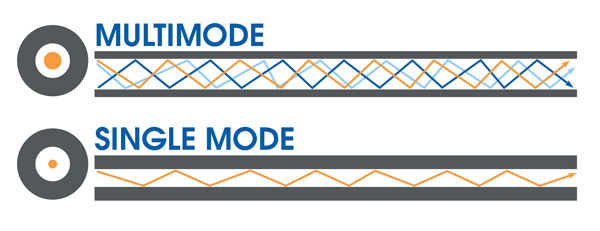

 Knowledge Base +
Knowledge Base +  2024.01.05
2024.01.05No, it is not recommended to mix single-mode and multimode SFPs in the same network. Single-mode SFPs are designed for long-distance transmission over single-mode fiber, while multimode SFPs are designed for short-distance transmission over multimode fiber. Mixing the two types of SFPs can lead to compatibility issues, data transmission errors, and network performance degradation. It is best to use the appropriate type of SFP for the specific fiber optic network requirements.
Fiber Optic Patch Cable Overview
Fiber optic patch cable, also known as fiber jumper or fiber optic patch cord. It is composed of a fiber optic cable terminated with different connectors on the ends. Fiber optic patch cables are used in two major application areas: computer work station to outlet and patch panels or optical cross connect distribution center. According to fiber cable mode, cable structure or connector types etc., fiber patch cable can be divided into different types.

1.Single-mode and Multimode SFP fiber Cable
According cable mode, patch cables can be divided into single-mode and multimode fiber patch cable. The word mode means the transmitting mode of the fiber optic light in the fiber optic cable core. Single-mode patch cables are with 9/125 fiber glass and are yellow jacket color, while multimode patch cables are with OM1 62.5/125 or OM2 50/125 fiber glass and are orange color. In addition, there is 10G OM3 and OM4 multimode patch cables which cable jacket are usually aqua.
2.Simplex and Duplex SFP fiber Cable
Simplex fiber patch cable is consist of single fiber core, while duplex fiber patch cable is consist of two fiber cores and can be either singlemode or multimode. Additionally, there is also ribbon fan-out cable assembly (ie. one end is ribbon fiber with multi fibers and one ribbon fiber connector such as MTP connector (12 fibers), the other end is multi simplex fiber cables with connectors such as ST, SC, LC, etc.).
3.LC, SC, ST, FC, MT-RJ, E2000, MU and MPO/MTP Patch Cable
Fiber optic patch cable can be also classified by the types of fiber optic connector. For example, LC fiber optic patch cable is named as it is with LC connector. Similarly, there are SC, ST, FC, MT-RJ, E2000, MU and MPO/MTP fiber optic patch cables. What's more, there are PC, UPC, APC type fiber patch cords, which are differentiated from the polish of fiber connectors.
Which SFP fiber Cable Should I Choose for My Fiber Optic Transceivers?
Now, I will take the Cisco fiber optic transceiver as an example to discuss this topic. For example, we need to choose a right patch cable to connect Cisco fiber optic transceiver SFP-10G-SR and X2-10GB-SR. Which patch cable to use? According to cisco 10-Gigabit Ethernet Transceiver Modules Compatibility Matrix鈥? we may know that SFP-10G-SR is the 10GBASE-SR SFP+ transceiver module for MMF, 850-nm wavelength, LC duplex connector. And X2-10GB-SR is the 10GBASE-SR X2 transceiver module for MMF, 850-nm wavelength, SC duplex connector.
Obviously, this two knids of optica trancseivers are both for MMF, so we should choose a multimode patch cable. Besides, we know X2-10GB-SR is designed for SC duplex connector and the SFP-10G-SR is designed for duplex LC connector, so we should use a patch cable with SC-LC duplex connector.

The Most Common Used SFP fiber Cable Selection
In the way mentioned above, you could choose right fiber patch cable for your other transceiver modules. Keep in mind that if your transceiver modules are not Cisco, you need to ask your brand supplier to get the corresponding compatibility matrix. In fact, in terms of a same kind of optical transceiver, different supplier may provide the transceiver with different specifications.
What is the difference between single mode vs. multimode fiber?
Single-mode fiber (SMF) and multimode fiber (MMF) are two types of optical
fibers used in telecommunications and networking. The key differences between
them lie in their core size and the way they transmit light: Core Size:
Single-Mode Fiber (SMF): SMF has a smaller core size, typically around 9
microns. The smaller core allows only one mode of light to propagate through the
fiber. This results in a single, tightly focused beam of light. SMF is
well-suited for long-distance communication and is commonly used in applications
such as telecommunications and data transmission over large distances.
Multimode Fiber (MMF): MMF has a larger core size, typically 50 or 62.5
microns. The larger core allows multiple modes of light to propagate through the
fiber simultaneously. Due to the larger core, the paths taken by the different
modes of light can vary, leading to different arrival times at the receiving
end. MMF is often used for shorter-distance communication within buildings or
campuses.
Distance and Bandwidth:
Single-Mode Fiber (SMF): SMF provides higher bandwidth and can support data
transmission over longer distances without signal degradation. It is suitable
for high-speed, long-distance applications.
Multimode Fiber (MMF): MMF has lower bandwidth and is generally used for
shorter distances. It is suitable for applications with lower data transmission
requirements over relatively shorter links.
Light Source:
Single-Mode Fiber (SMF): Typically uses a laser as a light source.
Multimode Fiber (MMF): Can use either light-emitting diodes (LEDs) or lasers
as light sources.
When choosing between SMF and MMF, factors such as the required bandwidth, transmission distance, and the specific application's needs play a crucial role in determining the most suitable fiber type for a particular installation.
Additional Learning Hub Resources
Can I use single mode equipment over multimode cable and vice versaHow to Convert
Can you use single mode fiber with multimode SFP
Subscribe to the newsletter
for all the latest updates.
2-5# Building, Tongfuyu Industrial Zone, Aiqun Road, Shiyan Street, Baoan District, Shenzhen. China
